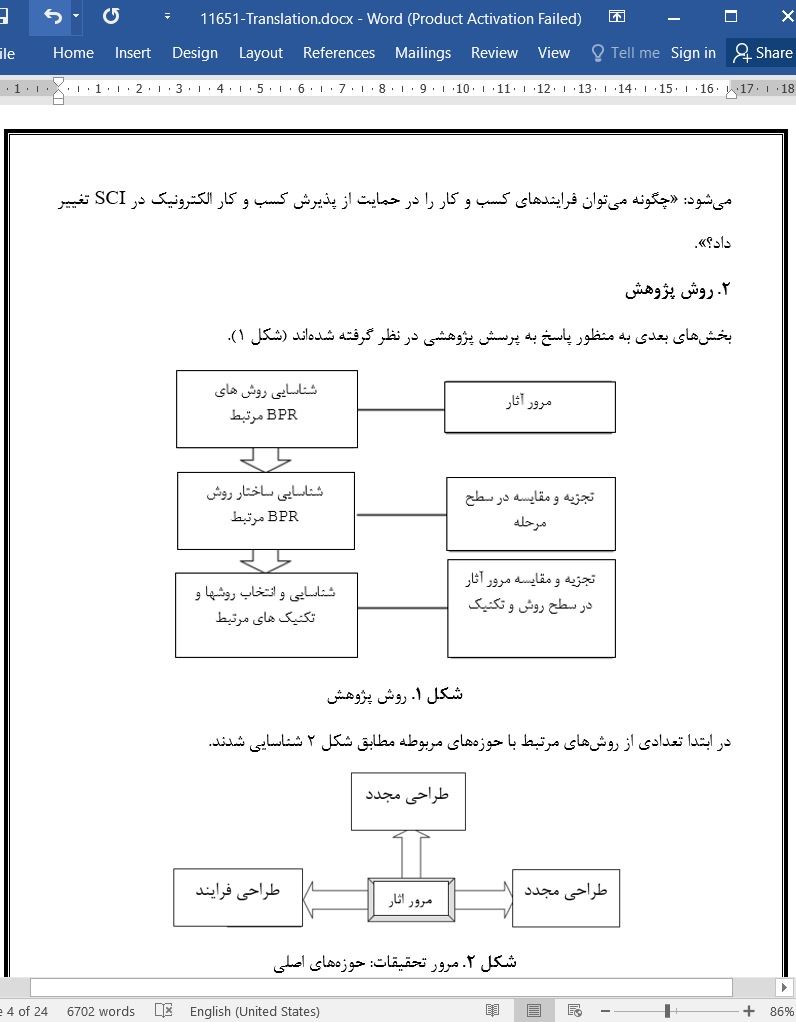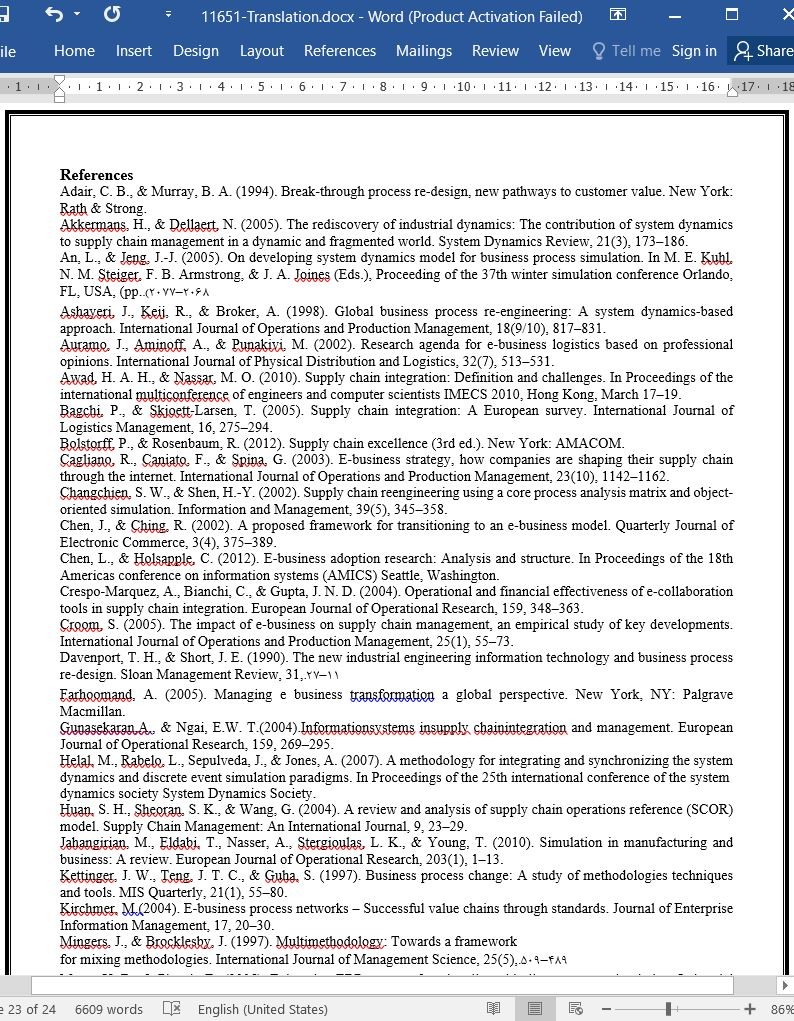
روش طراحی مجدد فرایند کسب و کار برای پشتیبانی از یکپارچه سازی زنجیره تامین
چکیده
با وجود روشهای موجود در طراحی مجدد فرایند کسب و کار (BPR)، طراحی مجدد زنجیره تامین (SCR)، و طراحی فرایند کسب و کار الکترونیک، هنوز چارچوب روششناختی یکپارچهای برای طراحی مجدد فرایند کسب و کار در جهت پشتیبانی از یکپارچهسازی زنجیره تامین (SCI) وجود ندارد. این مقاله، چارچوب دقیقی را بر اساس یکپارچهسازی تعدادی از شاخههای مختلف روششناختی تحقیقات ارائه میدهد. مروری بر تحقیقات در سه حوزه مختلف انجام شد: طراحی مجدد فرایند کسب و کار، طراحی مجدد زنجیره تامین، و طراحی کسب و کار الکترونیک. مرور تحقیقات، پتانسیل برای یکپارچهسازی عناصر تعدادی از روشها و تکنیکهای مختلف موجود در شاخههای مختلف روششناختی برای انجام BRP به منظور پشتیبانی از SCI را آشکار ساخته است. از اینرو، تعدادی از روشهای مربوطه در سطح مرحله و روش/تکنیک خود شناسایی، تجزیه و مقایسه شدند تا ترکیبی برای تدوین چارچوبی یکپارچه شناسایی شود. بنابراین روش BPR ارائه شده را میتوان در هر شرکت یا بخشی اعمال کرد؛ روشها و تکنیکهای تلفیق شده مختص بخش خاصی نیستند. روش BPR ارائه شده به فعالان زنجیره تامین در ساخت SCI کمک میکند.
1. مقدمه
1.1 . یکپارچگی زنجیره تامین
لزوم هماهنگی میان شرکای مختلف کسب و کار، بخشهای داخلی شرکت، فرایندهای کسب و کار و مشتریان متنوع در طول زنجیره تامین، اهمیت حوزه مدیریت زنجیره تامین (SCM) را آشکار میسازد (توربان، کینگ، لی، لیانگ و توربان، 2011). یکپارچهسازی زنجیره تامین (SCI) در مرکز کسب مزیت رقابتی از طریق SCM قرار دارد. هنگامی که یکپارچهسازی حاصل میشود، زنجیره تامین به عنوان موجودیت منفردی عمل میکند که بطور مستقیم توسط تقاضای مشتری هدایت میشود (فارهوماند، 2005). با این حال، تحقیقات زنجیره تامین، وجود چالشهایی در رابطه با یکپارچهسازی زنجیره تامین را نشان میدهند (آوارد و ناسار، 2010؛ بگچی و اسکجوت-لارسن، 2005؛ اسوینی، 2011). در میان این چالشها، به اشتراکگذاری اطلاعات، هماهنگی جریانهای فیزیکی مناسب و یکپارچگی فرایندهای کسب و کار به نظر میرسد که از اهمیت بیشتری برخوردار هستند (پراجوگو و اولهاگر، 2012؛ رابرتسون، گیبسون و فلانگان، 2002؛ ساهین و رابینسون، 2002).
4. نتايج
تحقیقات برخلاف مزاياي بالقوه كسب و كار اینترنتی در مديريت زنجيره تامين تعدادی از چالشهایی را پیسنهاد میدهند که مانع اتخاذ موفقیت آمیز آن میشود: به ويژه نياز به طراحي مجدد فرايند هاي كسب و كار. تعدادي از روشها بدست آمدهاند که طراحي مجدد فرايند كسب و كار، طراحي مجدد زنجيره تامين و طراحي فرايند كسب و كار اینترنتی را بررسی مي كنند. با وجود اين هيچ يك از اين روشها به ويژه چگونگي طراحي مجدد فرايند كسب و كار در حمايت از ساخت انسجام زنجيره تامين را بررسی نکردهاند. از طريق بررسي تحقیقات انجام شده در حوزههاي مختلف روشي تدوين و پيشنهاد شده است در اينجا تا به مقابله با اين مسئله خاص بپردازد. براي هر يك از مراحل روش طراحي مجدد فرايند كسب و كار روشها و تكنيك هاي مربوطه از تحقیقات مورد بررسي قرار گرفته، انتخاب و تركيب شدند. اين موضوع در شكل 13 خلاصه شده است.
Abstract
Although a number of methodologies exist for business process re-design (BPR), supply chain re-design (SCR), and e-business process design, there is a lack of an integrated BPR methodological framework to support supply chain integration (SCI). This paper proposes a detailed framework based on integrating a number of different methodological strands from the literature. A literature review was conducted in three different domains – business process re-design, supply chain re-design and e-business process design. The literature review revealed the potential for integrating elements of a number of different methods and techniques found in different methodological strands into a framework for conducting BPR to support SCI. Accordingly a number of relevant methodologies were identified, decomposed and compared at their stage and technique/method level to identify a combination for development of the integrated framework. The proposed BPR methodology can be applied in any company or sector; methods and techniques incorporated are not specific to any sector. The proposed BPR methodology proposed constitutes an aid for supply chain practitioners in the construction of SCI.
1. Introduction
1.1. Supply chain integration
The necessity to coordinate several business partners, internal corporate departments, business processes and diverse customers across the supply chain gave rise to the field of supply chain management (SCM), (Turban, King, Lee, Liang, & Turban, 2011). At the core of gaining competitive advantage through SCM is supply chain integration (SCI); when integration is achieved, the supply chain operates as a single entity driven directly by customer demand (Farhoomand, 2005). However the supply chain literature shows the existence of a number of challenges associated with the integration of supply chains (Awad & Nassar, 2010; Bagchi & Skjoett-Larsen, 2005; Sweeney, 2011). Among these challenges, sharing of information, coordination of physical good flows, and integration of business processes appear to be most critical(Prajogo & Olhager, 2012; Robertson, Gibson, & Flanagan, 2002; Sahin & Robinson, 2002).
4. Conclusions
Despite the potential benefits of e-business to supply chain management, the literature suggests a number of challenges preventing its successful adoption: in particular, the need to re-design business processes. A number of methodologies were found that address business process re-design, supply chain re-design, and ebusiness process design. However, none of these methodologies addressed, in particular, how to redesign business processes to support construction of supply chain integration. Through a literature review conducted in different domains, a methodology has been developed and proposed here to tackle this particular problem. For each one of the BPR methodology stages, relevant methods and techniques were reviewed from the literature, selected and combined. This is summarized in Fig. 13.
1. مقدمه
1.1 . یکپارچگی زنجیره تامین
2.1 یکپارچهسازی زنجیره تامین (SCI)
3.1 طراحی مجدد فرایند کسب و کار در حمایت از پذیرش کسب و کار الکترونیک در SCI
2. روش پژوهش
3. متدلوژی طراحی مجدد فرایند کسب و کار: روشها و تکنیکها
1.3 مرحله 1- دیدگاه و تعهد مدیریت در سطح بالا
2.3 مرحله 2- درک کسب و کار
3.3 مرحله 3- شناسایی فرایندهای زنجیره تامین مرتبط و انتخاب هدف طراحی مجدد.
4.3 مرحله 4- تعریف اهداف بهبود
5.3 مرحله 5- درک فرایند موجود
6.3. مرحله 6- طراحی فرآیند آینده
7.3. مرحله 7- پیادهسازی تغییرات
8.3 مرحله 8- ارزیابی تغییرات
4. نتايج
Abstract
1. Introduction
1.1. Supply chain integration
1.2. SCI construction
1.3. Business process redesign to support e-business adoption for SCI
2. Research methodology
3. Business process re-design methodology: methods and techniques
3.1. Stage 1 – top management commitment and vision
3.2. Stage 2 – business understanding
3.3. Stage 3 – identification of relevant supply chain processes and selection of target for re-design
3.4. Stage 4 – definition of objectives for improvement
3.5. Stage 5 – understanding the process AS IS
3.6. Stage 6 – design of process TO BE
3.7. Stage 7 – implementation of changes
3.8. Stage 8 – evaluation of changes
4. Conclusions
- اصل مقاله انگلیسی با فرمت ورد (word) با قابلیت ویرایش
- ترجمه فارسی مقاله با فرمت ورد (word) با قابلیت ویرایش، بدون آرم سایت ای ترجمه
- ترجمه فارسی مقاله با فرمت pdf، بدون آرم سایت ای ترجمه



